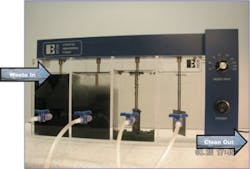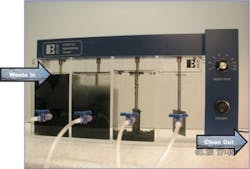Drilling is ahead of schedule on the first of two relief wells aiming to kill the flow from the runaway Macondo well on Mississippi Canyon Block 252 in the Gulf of Mexico, BP PLC reports.
The relief well being drilled by the Development Driller III was within 200 ft of the Macondo well, Kent Wells, senior vice-president of exploration and production, said during a June 18 technical briefing. He noted the pace will slow as the relief well locates and closes in on the Macondo well.
"Things have gone well down to this phase," Wells said, adding that the scheduled completion of at least one of the two relief wells remains sometime in August. "We're just looking at getting this well killed as soon as possible," he said of the blowout well.
On June 18, the relief well being drilled by the Development Driller III was at 15,936 ft, Wells said. A second relief well, being drilled by the Development Driller II, was at about 10,000 ft.
An Apr. 20 blowout caused an explosion and fire on Transocean Ltd.'s Deepwater Horizon semisubmersible, killing 11 crew members.
On June 23, BP appointed Bob Dudley as president and chief executive officer of BP's Gulf Coast Restoration Organization, effective immediately. Dudley reports to BP Chief Executive Tony Hayward.
Collection efforts
On June 21, BP collected 25,836 bbl of oil on MC Block 252 using both the Discoverer Enterprise drillship and the Q4000 multiservice vessel. The combined maximum capacity for the Enterprise and Q4000 is 28,000 b/d, said National Incident Commander and retired Coast Guard Adm. Thad Allen.
"That is a new record for us, and we continue to make progress in optimizing the capacity out of the wellhead there," Allen said on June 22.
BP's Wells said plans are proceeding to eventually remove the lower marine riser package cap now on the failed Deepwater Horizon blowout preventer (BOP). The LMRP cap likely will be replaced with a sealing valve cap. BP is considering three design options for the next cap.
A final decision on when to replace the LMRP cap is expected to be made in July at about the same time as BP installs floating riser systems that enable surface vessels to be disconnected and moved if a hurricane hits the gulf.
Allen said the first of two free-standing risers was being positioned on June 23. Wells said it was expected to be connected to the Helix Producer, a floating production unit, which will be connected to a tanker (OGJ, June 21, 2010, p. 29).
As a precaution, the LMRP cap temporarily was taken off the failed Deepwater Horizon BOP on June 23, Allen said.
As OGJ went to press last week, the incident was under investigation but it appeared a remotely operated vehicle accidently bumped into the LMRP cap and closed a vent, causing more pressure inside the riser.
At 8:45 a.m. CDT on June 23, a discharge of liquids was seen from the Discoverer Enterprise, BP said. Allen said the LMRP cap was removed while the safety of operations was evaluated.
Spill response crews reinstalled the LMRP cap at 6:30 p.m. CDT on June 23 Collection resumed at 7 p.m.
Removal of the LMRP cap allowed more oil to escape into the gulf while oil collection efforts are stopped on the Discoverer Enterprise drillship, Allen said.
However, oil continued to be collected and burned on the Helix Q4000 surface vessel. Oil directed to the Q4000 comes through the choke line of the BOP via a manifold on the seafloor and up a riser to the surface.
Separately, collection operations are being stopped on the Discoverer Enterprise containment system whenever lightning is a threat in a 5-mile distance of the drillship, Allen said June 21.
This precaution was taken because a lighting strike caused a small fire on the Discoverer Enterprise (OGJ Online, June 15, 2010).
Tracking the spill
Federal officials estimate oil has reached at least 120 miles of coastline, and the oil on the water is widely dispersed in thousands of small oil slicks rather than contained in one massive slick.
"We're dealing with a pretty expansive area of patches of oil right now," Allen said. "It's not a monolithic spill. It's literally a collection of hundreds of thousands of patches of oil. Some are miles long, and some are several hundred yards long."
A national inventory of skimming equipment and skimming vessels is under way, Allen said. Skimming equipment is towed behind vessels of opportunity—boats provided by individuals. These vessels range from small outboard motorboats to shrimp boats.
"Right now, in addition to the boom…the availability of skimmers is critical," Allen said. "We are in touch with the Department of Defense, using skimming capability they have at naval installations."
The 2,000 vessels of opportunity outnumber US Coast Guard vessels, Allen said, adding response crews are working to organize the vessels of opportunity into groups with a leader of each group.
"We are doing a number of things including putting tracking devices on some of these boats so we can have a better idea of where they're at," Allen said of vessels of opportunity.
Patches of oil are being tracked from the coast to 50 miles offshore, he said. The oil stretches from south-central Louisiana toward Fort Walton Beach, Fla.
More Oil & Gas Journal Current Issue Articles
More Oil & Gas Journal Archives Issue Articles
View Oil and Gas Articles on PennEnergy.com


